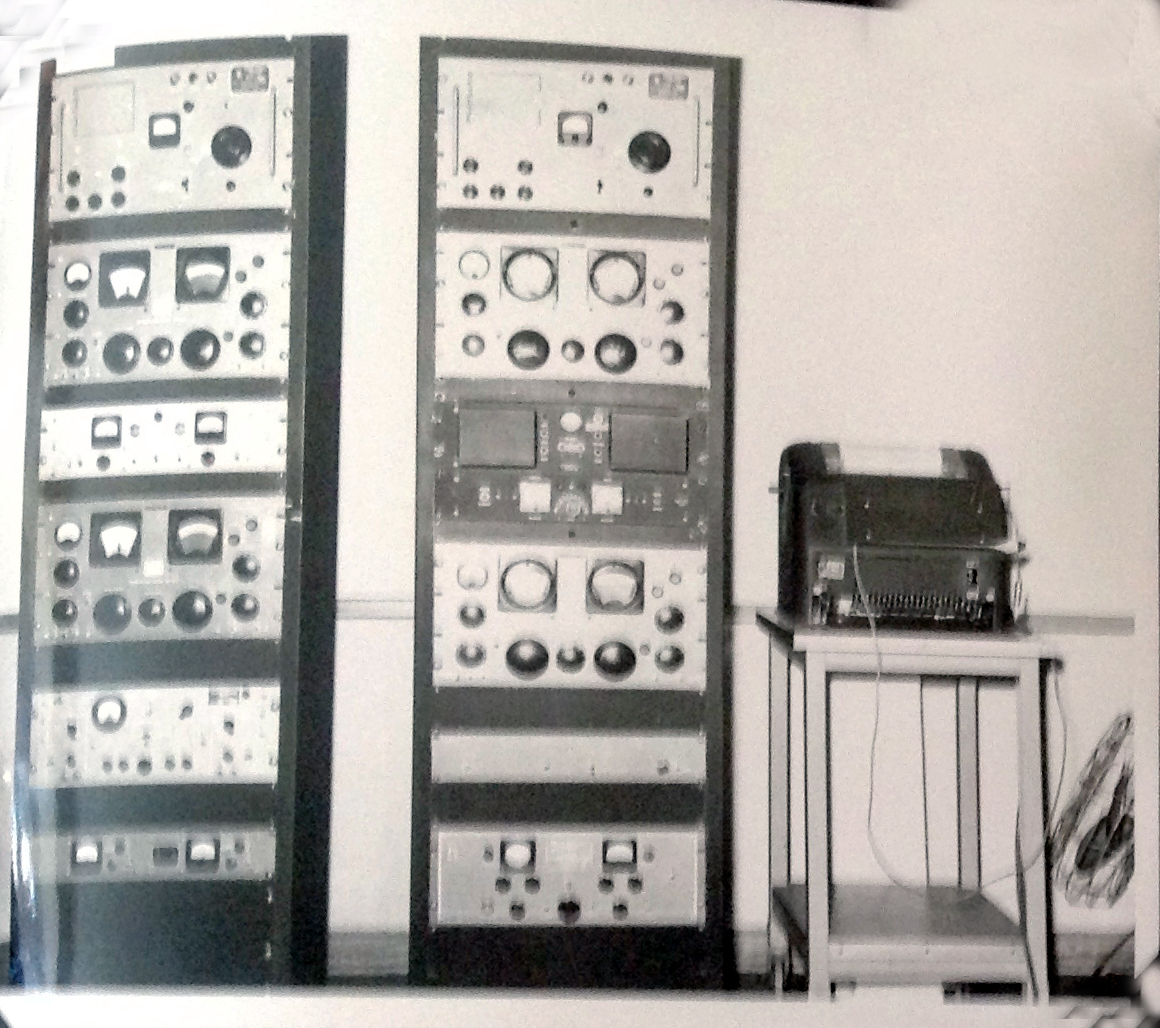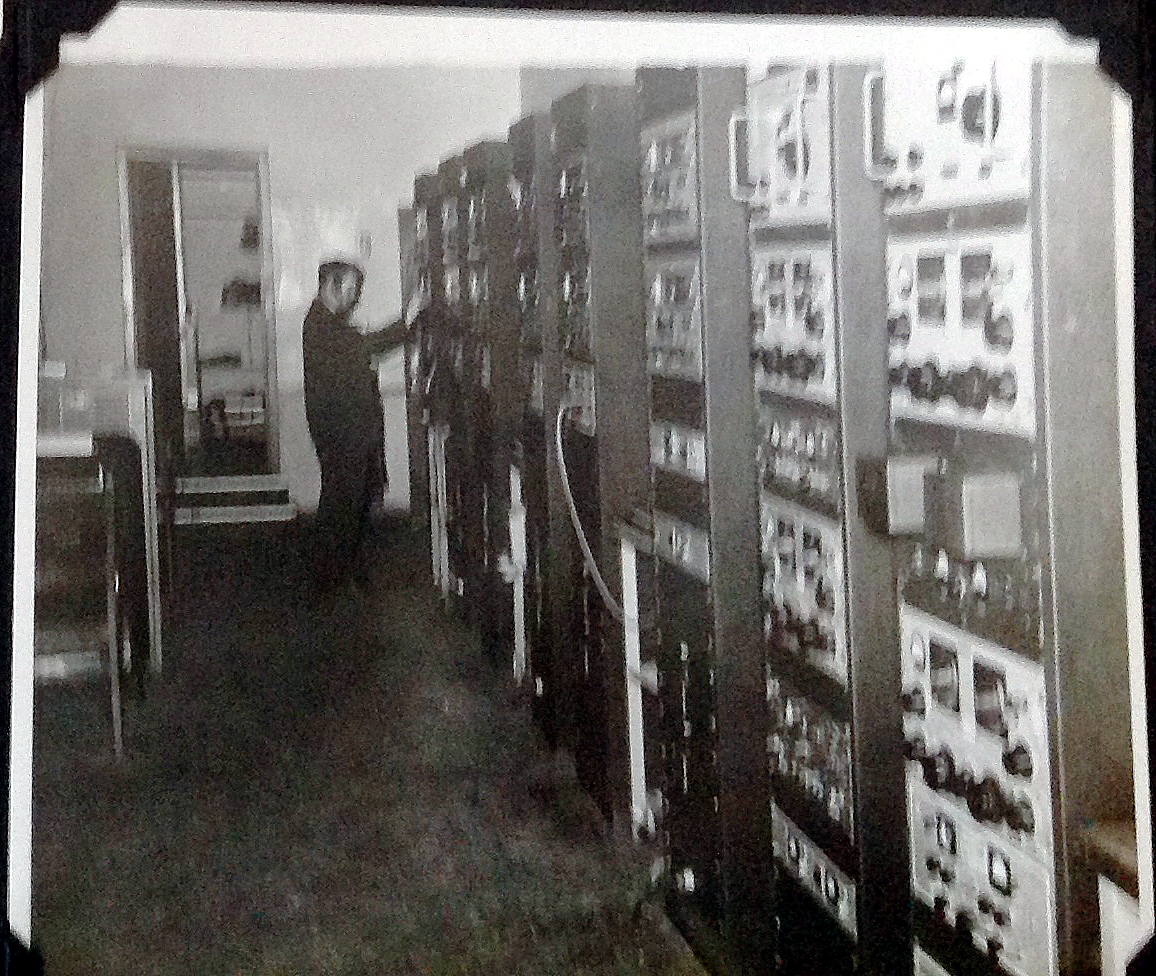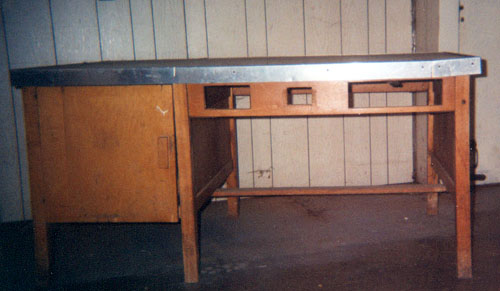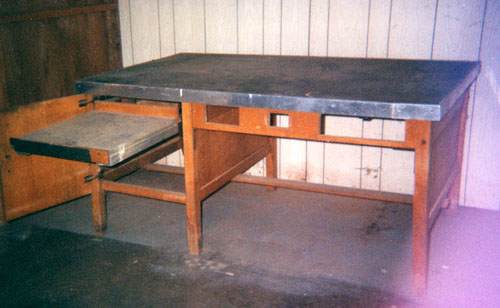INTRODUCTION
 CFS Leitrim, located just south of Ottawa, is Canada's oldest operational
signal intelligence collection station. Established by the Royal Canadian
Corps of Signals in 1941 as #1 Special Wireless Station and renamed Ottawa
Wireless Station in 1949, CFS Leitrim acquired its current name when the
Supplementary Radio System was created in 1966. In 1946, the station's
complement was 75 personnel. By 2005, the station had grown to 450 military
personnel and 28 civilian employees.
CFS Leitrim, located just south of Ottawa, is Canada's oldest operational
signal intelligence collection station. Established by the Royal Canadian
Corps of Signals in 1941 as #1 Special Wireless Station and renamed Ottawa
Wireless Station in 1949, CFS Leitrim acquired its current name when the
Supplementary Radio System was created in 1966. In 1946, the station's
complement was 75 personnel. By 2005, the station had grown to 450 military
personnel and 28 civilian employees.
PACERM PETERE, the station's motto means Research For Peace.
Crest Significance: The flashes indicate the role of the unit, while
the green belt refers to the location of the unit in the Ottawa green belt.
The crest of the Arms of Gloucester bears a maple tree. The fact that Leitrim
is in Gloucester Township is recognized by the maple leaf.
MISSION
Leitrim's mission is to:
* Operate and maintain signals intelligence collection and geolocation
facilities in support of the Canadian cryptologic program. interception,
decrypting and processing of communications for the Communications Security
Establishment
* Operate and maintain radio frequency direction finding facilities
in support of search and rescue and other programs.
* Maintain an operationally ready Cryptologic Direct Support Element
in support of military operations.
* Provide technical and logistic support to other units of the Canadian
Forces Information Operations Group.
Leitrim reportedly forms part of the world wide ECHELON system.
HISTORY
Leitrim's history and some operational information has been borrowed
from Bill Robinson's web document on Leitrim.
"In June 1942 # 1 SPECIAL WIRELESS STATION (SWS)
moved from Rockcliffe, Ontario to Leitrim, with operations commencing in
July. It was a two storey building surrounded by barbed wire. The top floor
contained a hand speed (Morse code) room and a high speed (machine generated
Morse) room combined with a compilation room. The lower floor contained
the offices for the Commanding Officer and his Station Warrant Officer,
a coffee room, tech shop and boiler room. The incinerator was located outside
the building. The antenna farm consisted of two Rhombic antennae, a Cage
antenna and a Screen antenna. Personnel who were involved in copying Morse
signals could not use a typewriter. The noise made by the typewriters was
too loud for the weak signals they were trying to copy.
In 1949, # 1 SWS became known as Ottawa Wireless Station (OWS)
and remained known as such until integration of the Canadian Armed Forces
on 11 July 1966. The name then changed to CFS Leitrim.
In 1946, the station's complement was 75 personnel. By 1959, it had
grown to about 200, by 1966, it was about 250, and, by the mid-1970s, it
was approximately 350. The complement at Leitrim in 1993, was reported
to be 400, of whom 250 or more are members of the Communicator Research
trade.
In 1987, the normal rank of Leitrim's commanding officer was upgraded
from Major to Lieutenant Colonel. This upgrade is related to an increase
in personnel at the station coinciding with the 1986 closure of Inuvik.
In July 1992, DND announced a $29 million expansion at the station including
the Operations Building extension. These are related to the Supplementary
Radio System project to convert Alert, Masset and Gander to remote operations.
Apparently, US Army and Navy SIGINT detachments existed at the station
during the 1950s and possibly later. There is no evidence of an Army detachment
currently at the station, but a detachment of approximately 25 US Navy
SIGINT personnel continues to exist at Leitrim. In December 1999 COMNAVSURFPAC
reported that "about 30" US Navy personnel were stationed at Leitrim".
In a major organizational shuffle, CFCCwas disbanded on 15 July 1994, with
its units be coming part of the newly created Defence In formation Services
Organization (DISO), which in turn became the Assistant Deputy Minister
Information Management Group (ADM IM). CFSRS saw its responsibilities grow
and was renamed Canadian Forces Information Operations Group (CFIOG). A
number of changes in the electronic information environment were taking
place in the mid 1990s that brought about the evolution of CFIOG.
The birthday of the Supplementary Radio System is officially recognized
as May 8, 1938. On that date , the Minister of National Defence approved
the establishement of a tri-service "Wireless Intelligence Service". This
was the first step in the development of the the RCN, Army and RCAF
in Supplementary Radio Activities. From 1938 to 1949, supplementary radio
activities were the individual responsibility of the three elements - the
RCN, RCAF and the Army.
On 19 July 1966, the Canadian Forces Supplementary Radio Systems (CFSRS)
was created in preparation of the unification of the Canadian Forces.
Stations previously controlled independently by the three services (indicated
in the parentheses) would now be directed by a Commander headquartered
at HMCS GLOUCESTER.
George Fraser comments on the most import accomplishment of SRS.
"I would say the most significant contribution made by our SUPRAD/SRS intelligence
gathering system was during the Cold War and specifically the Cuban Missile
Crisis. When President Kennedy was able to confront Chairman Khrushchev
and point out to him that 'we' are aware and have pinpointed the diesel
driven subs that were on their way to the Cuban area and that 'we' had
targetted all of the Soviet Nuclear subs sitting on the bottom off the
North American Coast from Newfoundland to Florida all of which would
be destroyed if he (Khrushchev) didn't pull back his ships from breaking
the U.S. Blockade. It was reported at the time that Khrushchev was visibly
shaken with this news and immediately altered his stance with respect to
delivering missiles to Cuba.
In addition, it is my opinion that our contributions were many and continuous
over the period and contributed in no small measure to the fact that we
were able to contain the Soviets through our intelligence gathering. For
example, we knew their aircraft, armies and naval forces movements throughout
the USSR as well as globally. This information provided the Americans with
the ability to target their warheads from silos across the U.S. on specific
targets. Hell....we could tell you how many truck loads of ore was being
moved in Siberia on a daily basis. These communications were in plain
language as were most of the Soviet communications in the very extreme
north even some military detachments. That is why we were so successful
in capturing the movements of their fighters when they scrambled in response
to U.S. overflights. The USSR radar units also communicated in plain language.
Our intelligence operators - Navy, Army, Air Force and civilian can
take great pride in the job they did in stopping the Russian Bear in his
tracks. Other areas in which our Intelligence excelled are too numerous
to mention. One had only need visit GCHQ or NSA to realize how Canadians
were held in very high esteem by these organizations"
What is not well documented is the role that civilians played at Leitrim.
The following was provided by a person who served at both Leitrim and Ladner.
"When I joined Leitrim in 1959-60, it was manned mainly by
civilians. The Commanding Officer and Station Warrant Officer were
both Army as well as a few other military staff. There was no RCN
or RCAF personnel present. Each of the watches (shifts) were 99%
civilian (about 15 per shift). Some were hired and trained on site while
many others were ex service personnel.
A civilian was in charge of operations along with his staff and day
workers. The techs were also 99% civilian. Antenna riggers were civilians
as well. The pay and admin staff was also manned by civilians. Gradually,
the military moved in preempting and easing out further civilian hiring.
Civilians were encouraged to volunteer at Alert. Some did, most did not.
They wanted the same pay as Dew Line operators.
Ladner was in approximately the same situation/ Although more military
served there, it was a 60-40 split in favour of civilian operators".
CFS Leitrim is composed of the following units:
76 Communication Group (76 Comm Gp)
The mission of 76 Communication Group is to provide IT support to National
Defence Headquarter Group Principals, Environmental Chiefs, their staffs,
and controlled units.
Canadian Forces Crypto Maintenance Unit (CFCMU)
The mission of the CFCMU today is to maintain and repair cryptographic
equipment, to perform acceptance testing on new cryptographic equipment
being brought into service, and to install strategic secure information
distribution systems (so-called "Red Distribution Systems") for the Canadian
Forces (CF) and other government departments. It is also to test, and to
do limited repair and modification, of fixed and mobile secure enclosures
shielded against electromagnetic emanations.
Canadian Forces Crypto Support Unit (CFCSU)
The mission of CFCSU is to provide communication security material
accountability, courier services, account inspections, third-level communications
security material support and management services, custodian training and
publish CF communications security publications and generation and distribution
of electronic keying material for CF cryptographic equipment.
Canadian Forces Data Centre (CFDC)
The mission of CFDC is to provide reliable and timely data processing
services to the CF. It is also to ensure backup recovery services for all
of its users in the event of an operational overload or an emergency.
Canadian Forces Electronic Warfare Center (CFEWC)
CFEWC is mandated with the development of the CF Electronic Warfare
Database (CFEWDB). This relational database contains information on a variety
of related subjects including emitter parametrics and platform and weapon
fitments. It is designed for use by the CF community at large as a single-source
reference on EW-related matters. Its development continues with the intention
of adding electro-optical and infrared signatures in the near future.
The station is located at 3545 Leitrim Road in Gloucester, Ontario.
Its military routing indicator for both secure and non-secure traffic is
RCCLEMA
Ed Sieb, VA3ES, has a Leitrim story to pass on. "Around 1992, while
monitoring the 10 metre band, I noticed some interesting and odd signals
about 29.454 MHz. They sounded like some type of net call-up,
in Russian. Having served in the Royal Canadian Corps
of Signals myself, I instantly realized what I was listening to. Indeed
it was a net call-up. I grabbed a tape recorder and started to record
the signals. At the same time, I called up Leitrim Station and spoke to
the Duty Officer, a Corporal. I gave all the information I had, the
frequency, mode, etc. He took it all down, thanked me and hung up.
About an hour later, in an effort to determine if indeed Leitrim had
intercepted these sigs, I called back and spoke to the same Corporal.
He refused to even acknowledge that they had heard anything, which
made sense, since any intercepts are considered SECRET and not to be discussed
with any third party, i.e. me! Fair enough.
About six months later, I met another ham, who by chance, worked at
Leitrim. I mentioned the incident to him. He acknowledged that
indeed he knew all about it, and could now reveal that my own interception
of the
Russians was quite useful to them. This was during the invasion
of the Baltics, just prior to the collapse of the Soviet system".
291 COMMUNICATIONS RESEARCH TRADE
October 1, 1966 saw the creation of the Military Occupation (MOC)
291 (Communicator Research Operator)
and the Radio Telegraphic Operators (R&TG) of the Royal Canadian
Signal Corps and the Royal Canadian Air Force Communications (Comm Op).
Now, the Comm Research occupation is not only involved with SIGINT operations
but with EW and Network Operations as well.
At one time, the Department of National Defence had a document posted
on the web called the "MOS Review Report, dated March 25, 1997". It was
a snapshot in time that was taken in the midst of the of the Alert/Gander/
Masset remoting project. Eventually this document was taken down because
it was outdated, however it does provide a glimpse into the 291 Communications
Research Trade up to the mid-1990 's period. Excerpts from this document,
preserved and provided by Bill Robinson, are listed below.
MOS REVIEW REPORT
COMMUNICATOR RESEARCH MOC 291
INTRODUCTION
1. Communicator Research operators/analysts are employed in support
of Canadian/Allied intelligence efforts, electronic warfare, and High Frequency
Direction Finding (HFDF). They use a broad range of sophisticated
electronic equipment to intercept and study foreign communications and
electronic transmissions.
2. The current A-PD-055-002/PP002 (last update 91-06-28) Canadian Forces
Manual of Military Occupation Structure (CFMMOS) does not accurately depict
1997 Communicator Research operations; work on updating this document will
be initiated after the CFSRS remoting and other related projects are completed.
General Communicator Research functions listed in A-PD-055 CFMMOS include:
a. collection, processing, reporting and distribution of
selected signals throughout the radio frequency spectrum;
b. receiving Morse and non-Morse transmissions;
c. operating receivers, demodulators, recorders and other
computerized communications systems;
d. participating in the National and Allied Search and Rescue
program;
e. maintaining approved standards of physical and communications
security; and
f. performing authorized operator equipment inspections
and initiating action for equipment repair.
3. Communicator Research specialties include:
a. Signals Development Operations;
b. Netted HFDF Operations;
c. Wideband Acquisition Operations;
d. Linguist Operations;
e. CENTERVELIC Operations;
f. Electronic Warfare Land Operations;
g. Cryptologic Direct Support Element Operations;
h. Communications Satellite Operations; and
i. Communications Centre Operations.
Select this link for a 291 job
description. (Provided by Dave Berry.)
LIMITATIONS
Positions used in this report are based on the DEPR Automated Establishment
Report (AER) and REMAR for Comm Rsch 291 dated 31 Oct 1996. Because of
the continuous personnel requirement changes being brought about by the
reorganization of the Canadian Forces Information Management (IM)/Information
Warfare (IW) Directorate, and the remoting of Canadian Forces Supplementary
Radio Systems (CFSRS) operations from CFS Alert, 770 Comm Rsch Sqn Gander
and CFS Masset to CFS Leitrim, this is not an accurate depiction of the
Communicator Research occupation requirements for 1997/98.
NOTE: Current estimated PML for Comm Rsch 291 personnel Forces wide
in 1997 is 668 with 570 employed
directly in CFSRS. There is a forecasted (but not yet approved)
increase in Support to Military Operations (SMO) positions. This
will involve ECP action on current billets but will not change the overall
PML.
FIRST AND SECOND LINE UNITS
Although there are no hard Comm Rsch billets assigned to first or second
line units, there are personnel employed in MARCOM in new positions aboard
HMCS Athabaskan (280 Class); unfortunately, these positions are staffed
with military manning overhead (MMO) personnel because of the MARCOM personnel
freeze. Even though a specialized equipment suite has been built into the
ships operations which must be manned by Comm Rsch, the occupation does
not get credit for staffing them. In further support to MARCOM, personnel
employed on permanent Cryptologic Direct Support Element (CDSE) teams both
at Halifax and Esquimalt are identified under CFS Leitrim's REMAR not MARCOM;
currently at 29 positions, there has been strong interest in having the
CDSE compliment increased to 40 positions. There is also a request,
being staffed at the Comd SRS level at present, to provide another 10 positions
to MARLANTHQ in APS 97. The issue of MARCOM providing establishment
positions for these personnel will have to be addressed.
NATIONAL ASSETS
There are 53 personnel serving in National Asset Units: 51 in 1 CDHSR,
2EW Sqn; and two in the Res EW Sqn Kingston (subordinate to CFSRSHQ). To
ensure the guaranteeing factor criteria is met, an additional 18 trained
personnel must be available to support the National Assets should deployment
be required. After APS 97, the majority of Comm Rsch personnel will
be employed within ADM(DIS) units; guaranteeing factor numbers should be
distributed equitably throughout ADM(DIS) to ensure minimum disruption
to intelligence operations.
Difficulties are foreseen in providing the National Asset guaranteeing
factor. Land EW operations/skill sets are unique to personnel serving
in LFC and the Res EW Sqn. Personnel outside of these units do not
have the expertise to act as emergency replacements for EW operations.
Finding ways to keep replacement personnel current on the land EW operational
positions is extremely difficult.
Realistically, it is impossible to tie the guaranteeing factor numbers
to individual billets located outside of the National Asset units because,
in all likelihood, the person serving in the billet flagged would not have
the experience or skill sets required. To alleviate or minimize the
problem, sufficient personnel should be rotated through the LFC EW environment
each APS to ensure trained EW Specialist's are available for deployment
sustainment. Consideration should also be given to granting high
level, Special Access (SA) security clearances to reserve personnel in
the Kingston Res EW Sqn to train as guaranteeing factor replacements.
Minimum operational requirement (MOR) for national assets Number of
positions in national asset units is 71 positions. Currently there are
53 staffed leaving a shortfall of 18 positions.
MINIMUM OPERATIONAL REQUIREMENT
The process of achieving the Minimum Operational Requirement (MOR) to
support Contingency Operations is through a comparison by rank of all positions
required in either the Contingency Force or Vanguard elements and selecting
the higher of the two figures. The total number of Comm Rsch 291
required for the main contingency force is 71. This is sufficient
to sustain the Vanguard total of 69.
SUMMARY OF THE REMAINING SECTIONS OF THIS REPORT
There are major problems and unique factors to consider when trying
to determine if a Communicator Research position should be military or
not. The skill sets required for the Comm Rsch occupation, for the
most part, have no established equivalent or employment stream in the public
sector. There is no curriculum available through university or community
college which would prepare a person for a career as a signals intelligence
(SIGINT) operator. Portions of comparable skill sets which are used
by other government departments such as the Canadian Coast Guard and Industry
Canada's Spectrum Services are developed in-house and on a much reduced
scale; the civilian counterparts have significantly different applications
than those required by the DND intelligence community. Foreign country
communications protocols/procedures, modulation techniques, radio frequency
propagation, and Morse code at speeds in excess of 30 WPM [1] are but a
few of the unique trade requirements.
Every year CFSRSHQ surveys all Commands to determine forecasted Support
to Military Operations (SMO) linguistic support requirements. Comm
Rsch training for and provide linguistic support for SMO deployments.
Languages currently available are Arabic (Farsi/Iraqi/Saudi), Czech, Creole,
German, Korean, Russian, Serbo-Croat, Spanish, Portuguese, and Chinese
(Mandarin). Also available are native speakers in Japanese, Dutch, Icelandic,
Hungarian, and Greek. Language courses range in length from approximately
6 months in the Spanish-to-Portuguese conversion to 2 years in the case
of Korean and Mandarin. Multi-lingual individuals are not uncommon
with some able to work in up to 5 languages.
No formal manpower credit is given to the Comm Rsch occupation for maintaining
a linguist cadre. There is a large number of linguists (eg: 140+
Russian) who, in most cases are not always employed using their specialty,
nonetheless, they are still expected to maintain competency by training
on their own time or through language maintenance programs at their home
unit. Language requirements cannot be tied to specific billets because
there is no way to determine the target language of the day. The
specialist resource pool is used as required, frequently deploying on short
notice.
MILITARY NON-ESSENTIAL POSITIONS
A total of 241 (31.4%) positions were identified as non-core military
non-essential (MNE) positions. While these positions could be considered
to have potential for ASD, the tremendous changes ongoing in the MOC as
a result of downsizing/remoting indicate that we should wait until these
projects are finalized prior to initiating ASD studies. Additionally,
the finalization of the establishment positions required by MARCOM will
have an impact on the number of positions suitable for ASD consideration.
Positions identified as MNE in this report may actually be staffed by
linguists or other OSQ personnel who do not need their specialties in the
day-to-day operations of their present job, but must still be gainfully
employed until required.
One significant factor that future ASD studies must consider if recommending
civilian replacements for current military staff is the Comm Rsch occupation
had a civilian job classification counterpart until the 1980's when it
was phased out. This was done in order to simplify management of personnel
resources, avoid awkward staffing constraints such as closed competitions
due to security clearances, and to avoid a classification with a severely
restricted career path.
MOC STRUCTURE
The current MOC structure does not reflect the final end-state for the
Comm Rsch trade. This will not be available until the SRS projects
are finalized and the MARCOM and other establishment position requirements
are addressed.
TRAINING REQUIREMENTS/SPECIFICATIONS
The remoting of CFSRS operations from isolated locations to CFS Leitrim
has had a most significant impact on the training requirements of the occupation;
a totally different operational environment now exists. Because of
the cost of the new equipment, CFSCE was not nor will be fully equipped
to train Comm Rsch operators in actual field conditions.
IAW Comd SRS Training Directive 1/95, a Training Study Committee comprised
of Comm Rsch subject matter experts (SME) and CFSCE instructional and standards
staff was formed in November 1995 to determine post-remoting requirements.
The final report was presented in May 1996 and approved in principle for
planning purposes in June 1996. A training implementation team
was staffed in September 1996 and is actively developing courses and modifying
existing material to reflect new field requirements; to ensure CFRETS standards
are maintained, CFSCE E Sqn training staff and the CFSCE HQ senior standards
advisor (SSA) Comm Rsch continue to be involved in course development.
Because of the lack of equipment at CFSCE E Sqn, the training study
committee recommended that all Comm Rsch specialty training be conducted
at CFS Leitrim; QL training should remain at CFSCE. If/when training
responsibility is transferred to CFS Leitrim Trg Dept., personnel identified
on CFSCE REMAR as specialist instructors should be reallocated to CFS Leitrim.
RECOMMENDATIONS
* The ASD process for Comm Rsch MOC 291 should be delayed until the
downsizing/remoting activities are complete and the occupation is fairly
stable. By this time there should be accurate job descriptions for
major task areas and a clearer picture of what future Canadian intelligence
requirements will be.
* Staff ECP's to harden Comm Rsch CDSE positions in MARCOM.
*Rotate sufficient personnel through National Asset units to ensure
a pool of trained EW specialist are available to support Core requirement
guaranteeing factor.
* Grant SA Security clearances to reservists to who can be trained to
meet the Reg Force EW Standard. This would form the guaranteeing
factor personnel base.
* Identify sufficient non-Core MNE positions as MER Linguist (various
languages) billets for support to military operations. These billets
would form the nucleus of the SMO linguist cadre.
* Every effort should be made to ensure the final Comm Rsch 291 PML
rank to rank ratio provides all personnel with reasonable opportunity/expectations
for promotions throughout their career.
* When specialist training is removed from CFSCE E Sqn curriculum, transfer
instructor billets from CFSCE to CFS Leitrim Training Dept.
* Update A-PD-055-002/PP-002 Canadian Forces Manual of Military Occupational
Structure as soon as accurate trade description is available.
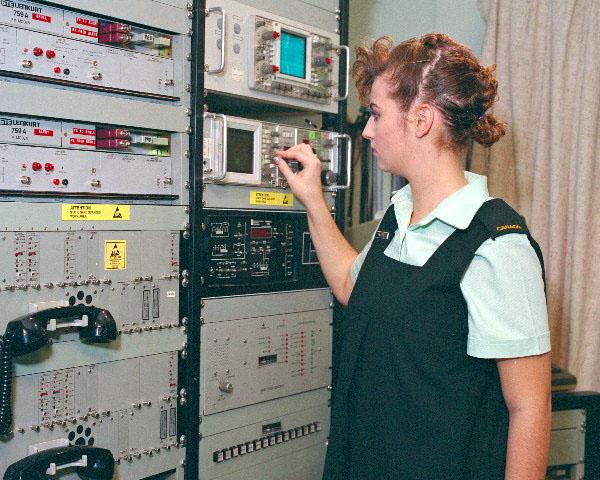 |
| 291 Operator at Work (#1) This 291 operator is monitoring equipment
associated with the HADACS satellite link which connects Ottawa to the
Skull Point earth station on Ellesmere Island. (Photo # REC90
1293 courtesy DND, Canadian Forces Joint Imagery Centre provided via Robert
Langille) |
|
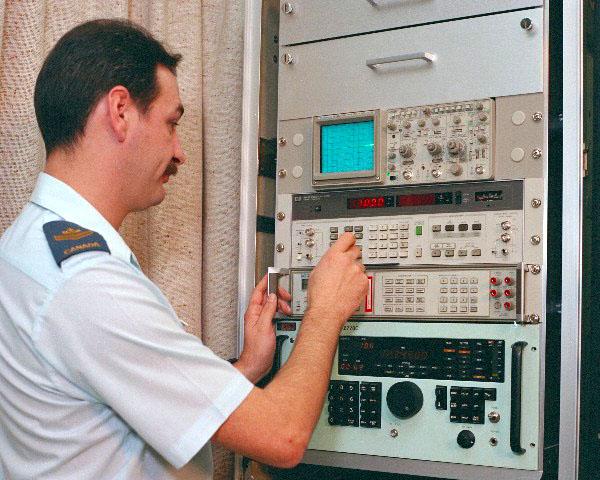 |
| 291 Operator at Work (#2). From top to bottom , the operator is using
1) Tektronix , 100 MHz Digital oscilloscope, Model 2230. 2) H-P Model
8903B Audio Analyzer. 3) H-P Unknown. 4) Racal 6778C receiver. Does
anyone know the purpose of this configuration? (Photo # REC90 1294 courtesy
DND, Canadian Forces Joint Imagery Centre provided via by Robert
Langille) |
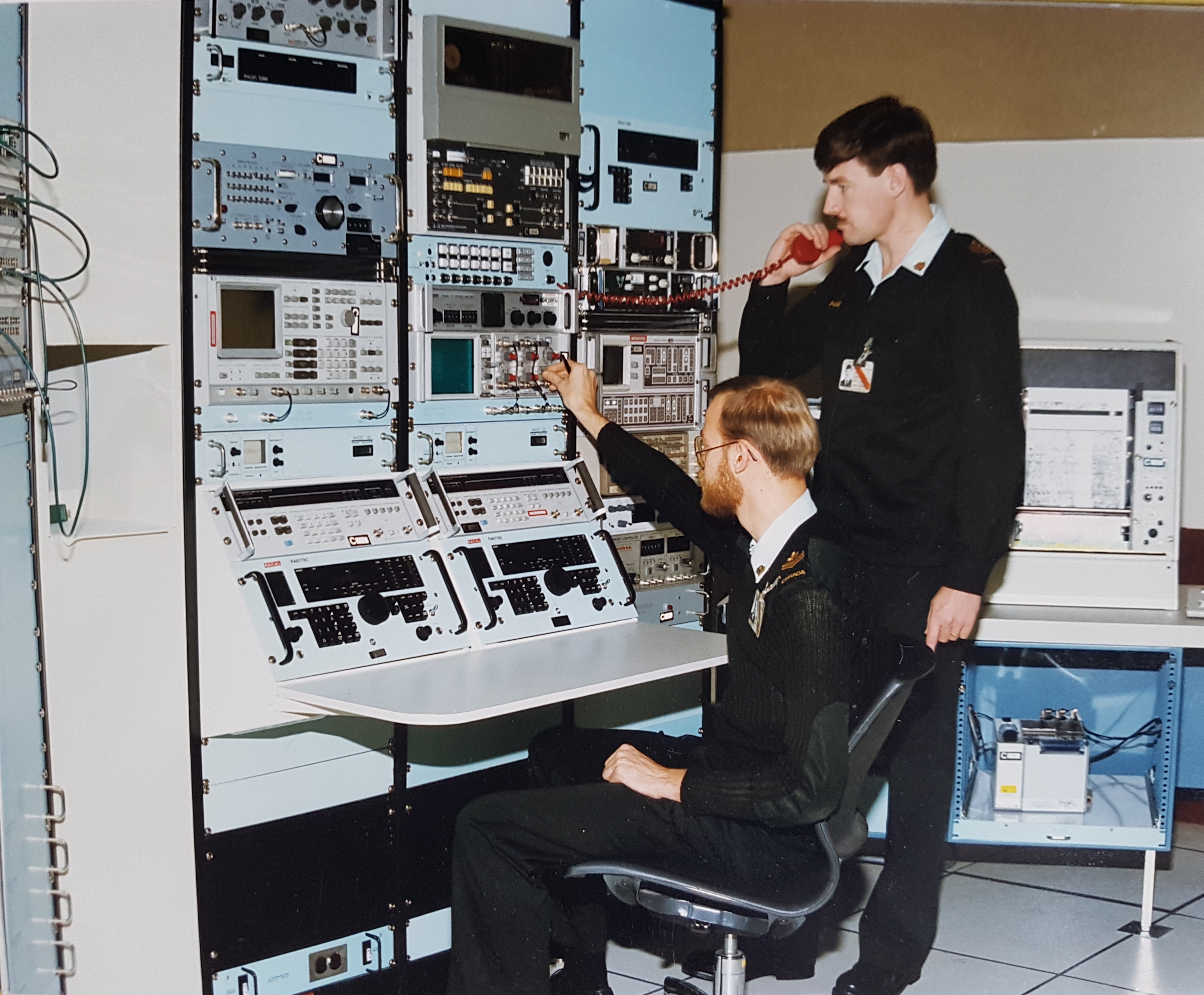 |
| SIG DEV training bay - 1980s. Click on image
to enlarge. (DND photo) |
Chris Collin, a former 291 operator, offers some insight about equipment
used by the 291 trade. "As of result of prevailing security, most kit was
destroyed after it became obsolete. As the trade moved from operator/maintainers,
to just operators, our connection with the equipment became somewhat distant
in certain respects. We had techs to take care of equipment problems
but they rotated in and out of the Supplementary Radio System. At
times they did not always have the intimacy with the equipment that one
might expect. As a SigDev'er, we were certainly close to our
equipment, but once, and on a very dull mid-watch, I counted
150 different pieces of gear in the racks which I used while executing
my duties. That was a lot to keep track of, especially when equipment
was superseded by something of the same functionality but bearing a new
model number"
Chris goes on to comment about the 291'ers workplace. "Whenever an uncleared
visitor entered a secure area, it took a lot of work to render the
area "safe". We always made sure there was no "sensitive" paperwork or
manuals left in easy view. If there was any photography, it really took
a lot of preparation since we basically had to hide many items out of view
of the camera. Luckily photography of a secure area was an infrequent
event! "
MOC 294 was the technical side (more or less) of the 291 trade.
294er's were ex 291er's and had the necessary security clearance required
to work in a SIGINT environment. Their job was to maintain the electronics
in support of the SIGINT function.
The Canadian Forces no longer has Military Occupation Codes (MOC) therefore
MOC 291 no longer exists. MOC's have been replaced with Military
Occupational Structure Identification Codes (MOSID). They are five digit
codes, and 291ers have been classified under MOSID 00120.
RADIO TECH TRADE
Michael Pierce, a Master Warrant Officer in 2012, joined the Canadian
Forces in 1982 and trained as a technician. He provides a brief history
of the Radio Technician trade.
As a result of the Unification of the Canadian Forces in 1968,
all CF personnel wore the same green uniform.
Recruit Training (Boot Camp) was done in Cornwallis, NS. Performance
Orientated Electronics Training was completed at The CF School of Communications
and Electronics (CFSCE) in Kingston.
From here, the training split into multiple directions. On the dedicated
Air side were the:
IE Instrument Electrical (551) tech
IS Integral Systems (521) tech
CS Communication Systems tech
RS Radar Systems tech
These trades worked exclusively on aircraft and they received their
specialized training at CFB Borden.
On the ground side we had:
Radio Techs (221) maintained communications equipment.
Radar Techs (231) maintained radar equipment.
Terminal Equipment Techs (222) maintained terminal equipment ie telephone
systems.
Teletype Techs (223) Maintained teletype equipment.
The Rad Techs were Jack-of-all-trades. On the big air bases, the
Rad Techs maintained communications equipment used by Air traffic control,
mobile support equipment, etc. We also maintained TVs, VCRs, etc and eventually
all IT/ADP as well.
Comm Tech (224) (any of the above 200 series trades when they
reach the rank of Warrant Officer)
These trades worked on everything except aircraft. The Navy had similar
trades, and I am not aware if any of the above techs ever being aboard
ships. In the late 80s, the individual elements were once again recognized
(Air, Land, Sea) and with the change back to Distinctive Environmental
Uniforms for the Air Force, Army and Navy (blue, green/tan, white/black).
In the late 1990s, new trade names were assigned.
All the 200 series that worked for the Air Force became ATIS (226) Techs
with blue uniforms.
All the 200 series that worked for the Army became LCIS (227) Techs
with green uniforms..
There was a third trade, SIS (225) that maintained "special" equipment
that fell between the blue and green trades. Incidentally, this trade concentrated
on specialized equipment like that found in Alert. This trade was
dropped shortly after, and the 226/227 trades picked up the slack.
I was in Alert in 1994. Officially, I was a Radio tech, wearing
a blue uniform".
2003
 CFS Leitrim, located just south of Ottawa, is Canada's oldest operational
signal intelligence collection station. Established by the Royal Canadian
Corps of Signals in 1941 as #1 Special Wireless Station and renamed Ottawa
Wireless Station in 1949, CFS Leitrim acquired its current name when the
Supplementary Radio System was created in 1966. In 1946, the station's
complement was 75 personnel. By 2005, the station had grown to 450 military
personnel and 28 civilian employees.
CFS Leitrim, located just south of Ottawa, is Canada's oldest operational
signal intelligence collection station. Established by the Royal Canadian
Corps of Signals in 1941 as #1 Special Wireless Station and renamed Ottawa
Wireless Station in 1949, CFS Leitrim acquired its current name when the
Supplementary Radio System was created in 1966. In 1946, the station's
complement was 75 personnel. By 2005, the station had grown to 450 military
personnel and 28 civilian employees.

